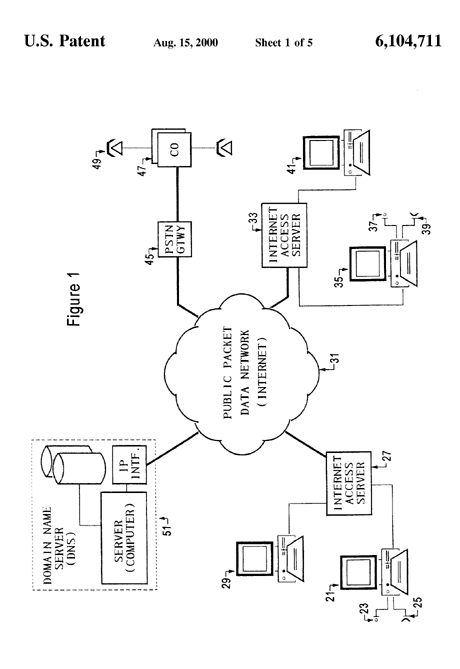Verizon-Vonage Patent analysis Part Two: 6,104,711

Now we will check out Verizon's patent 6,104,711 - Enhanced internet domain name server.
To me this is the most overgeneralized of all Verizon's claims. As a matter of fact, this is a patent granted to Verizon's predecessor Bell Atlantic back in 1997.
The Patent Abstract describes:
An enhanced name translation server, for use on a packet data network such as the Internet, executes a conditional analysis in response to at least some queries or requests for name translations.
For example, the server may return a different destination address at different times or in response to translation requests from different terminals. The server also can query a primary destination terminal device, and condition the response to the calling terminal on the status of the primary terminal.
For example, if the primary terminal is `live` the server forwards the address of that terminal to the calling terminal device to set up communications. Otherwise, the server returns alternate destination address information.
The server also supports a wide variety of different types of translations, including domain name to address, domain name to telephone number, and telephone number to address.
The enhanced translations offer called customers numerous options for controlling communications directed toward them, and the customers may elect to apply these options both to their data communications services and their voice communications services through the packet data network.
These sections have thus far been cited as infringing:
15. A method comprising:
receiving a name translation request at a server coupled to a public packet data network;
executing a conditional analysis in response to the name translation request;
if the conditional analysis produces a first result, translating a name included in the name translation request into a first destination address;
if the conditional analysis produces a second result, translating the name included in the name translation request into a second destination address; and
transmitting a response message containing the first or the second destination address to a calling device for use in establishing communication at least partially through the public packet data network.
20. A method as in claim 15; wherein:
the first and second destination address includes a numeric Internet Protocol address; and
the second destination address further includes information relating to call routing via a public switched telephone network.
I will show you Figure 1, and then get involved with the most relevant description sections:
Here is Figure 1:

I think this is what you need to know about what is being shown in that Figure, and how that relates to patented functionalities that Verizon thinks Vonage is infringing upon:
As shown in simplified form in FIG. 1, the domain name server (DNS) 51 comprises a server computer which functions as the central processing unit of the domain name server. The computer has an IP packet data interface to the network 31. The DNS system 51 also includes a data storage system storing a series of databases attached to or incorporated into the server. As discussed more below, the databases include look-up tables for direct translations of names to addresses and routing control records for conditional processing of requests for communication with at least some customers.
Essentially, when a person wishes to initiate a communication, they instruct their PC to start communication using a name address. The PC transmits a name translation request or `query` to the domain name server system 51 via the appropriate access server and the network 31. The server 51 receives the a domain name query from the public packet data network 31. In response, the server may execute a direct look-up table based translation to an IP address or telephone number. However, for any called party customer who has established a more sophisticated routing service, the server 51 will execute conditional analysis in response to the domain name translation query.
In its simplest form, if the conditional analysis produces a first result, the server 51 translates a name included in the query (e.g. domain name or telephone number based name) into a first destination IP address. If the conditional analysis produces a second result, the server 51 translates the name included in the query into a second destination IP address. The server then transmits a response message containing the first or the second destination address to a calling PC. The PC uses the received IP address to establish the desired communication through the public packet data network 31.
The name processing may apply to data communications as well as to voice telephone type communications through the packet data network 31. Also, the conditional analysis name processing may utilize a variety of criteria relating to the communication, such as the identity of the calling party or terminal, the time, the status of a primary destination terminal, etc. The conditional processing by the domain name server 51 will support a wide array of selective routing services, such as routing to different destinations at different times, routing to an alternate destination if a primary destination is inactive, follow-me type service, etc.
I'm a blogger, not a lawyer- but doesn't this sound overly generic to you?
One more patent to go....